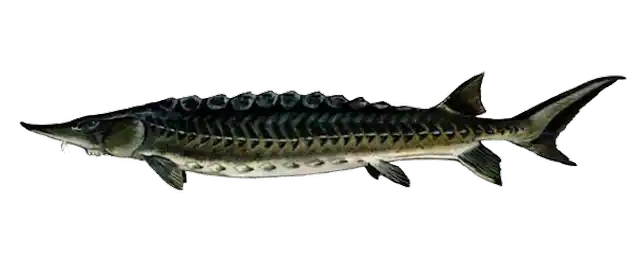Types of sturgeon fish | Characteristics & size of sturgeon fish

Found in various parts of the world, sturgeon fish belong to the family Acipenseridae, making them ancient aquatic giants that have inhabited our planet for millions of years. These remarkable creatures possess distinct characteristics and are known for their longevity, large size, and prized caviar. In this article, we will explore the different types of sturgeon fish that grace our waters.
Beluga (Huso huso):
The largest and most sought-after member of the sturgeon family, the Beluga Huso huso resides primarily in the Caspian Sea and Black Sea basins. Known for its immense size, this fish can grow up to 20 feet long and weigh over 3,000 pounds. Furthermore, its delicate gray caviar is widely regarded as some of the finest in the world.
Beluga Caviar (Beluga Caviar 30g) is a very valuable and luxurious food product made from the eggs of beluga Huso huso, a large fish found mainly in the Caspian Sea.

Kaluga Sturgeon (Huso dauricus):
Closely related to the Beluga, the Kaluga sturgeon, also known as the river beluga, inhabits the Amur River basin in Russia and China. It is renowned for its grandeur, reaching similar sizes to the Beluga Huso huso, making it another highly valuable source of caviar production.

Russian Sturgeon (Acipenser gueldenstaedtii):
Native to the Caspian and Black Seas, the Russian sturgeon, also known as the diamond sturgeon, is the most abundant sturgeon species. Around 25 species make up the Russian sturgeon complex. Recognizable by its elongated body and distinctive snout, this fish can reach up to 8 feet long and possesses a highly sought-after caviar variety.

Atlantic Sturgeon (Acipenser oxyrinchus):
The Atlantic sturgeon is primarily found along the eastern coast of North America, ranging from Canada to Florida. Historically, its population was plentiful; however, overfishing and pollution have drastically reduced their numbers. These sturgeons have a unique lifecycle, spending most of their lives in saltwater before migrating to freshwater rivers to spawn. Unfortunately, they are currently labeled as endangered species due to their declining population and are now subject to strict conservation measures.

White Sturgeon (Acipenser transmontanus):
The White sturgeon is the largest freshwater fish in North America, mainly residing in the Pacific coastal rivers of Canada and the United States. Known for its bottom-feeding behavior and bony plates called scutes, this species can reach impressive sizes, exceeding 20 feet in length and weighing over 1,500 pounds. The White sturgeon is commercially fished for its meat, and its eggs are used in caviar production, albeit less sought after than other sturgeon species.

Siberian Sturgeon (Acipenser baerii):
Originating from the Siberian rivers and located primarily in Russia, Kazakhstan, and China, the Siberian sturgeon is highly valued for its caviar production. It boasts an elegant appearance with its light gray to black scales and can grow up to 7 feet long. The Siberian sturgeon is also known for its adaptability to various environments, including both freshwater and brackish water.

Chinese Sturgeon (Acipenser sinensis):
The Chinese sturgeon, often referred to as the Yangtze sturgeon, is one of the most endangered sturgeon species. Native to the Yangtze River in China, it is recognized for its paddle-like snout and long, slender body. These sturgeons can grow up to 10 feet long and are a critical symbol of conservation efforts to protect the biodiversity of the Yangtze River basin.

In conclusion, sturgeon fish are fascinating creatures that have been around for millions of years. They are known for their unique characteristics, such as their elongated bodies and bony plates called scutes. The five main types of sturgeon include the Beluga, Sterlet, Osetra, Sevruga, and Kaluga. Each type offers distinct features and flavors, making them highly sought after for their roe, often known as caviar. However, due to overfishing and habitat loss, sturgeon populations have drastically declined, leading to their status as endangered species. It is crucial that efforts be made to protect and conserve these magnificent fish for future generations to appreciate and enjoy.
Source:
https://www.biologicaldiversity.org/White Sturgeon | Acipenser transmontanus | Fishing with Rod







